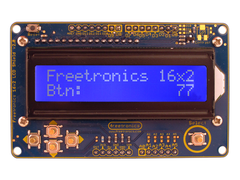Making your own test equipment is always fun, and a popular device is often the frequency counter. Previous DIY efforts may have involved many logic ICs and some complicated PCB work, however with the Arduino platform you can make your own in no time at all. This has been demonstrated by Harry Axten with his version that can measure up to a maximum of eight megahertz.
The required hardware is incredibly simple, and is basically an Arduino-compatible circuit with an LCD module and external parts to receive the signal. Harry has chosen to build a minimalist Arduino-compatible on prototying board, and mount the project in the neat case shown below:

The sketch side of the project has also been simplified thanks to the use of an Arduino frequency counter library. To learn more, check out Harry's project page. And for more, we're on twitter and Google+, so follow us for news and product updates as well.
If you're using an LCD with your Arduino-based projects - instead of building your own LCD module onto a breadboard, save time and move forward with the Freetronics LCD & Keypad shield which contains a bright 16x2 character LCD and five buttons that can be read from only one analog input pin:











